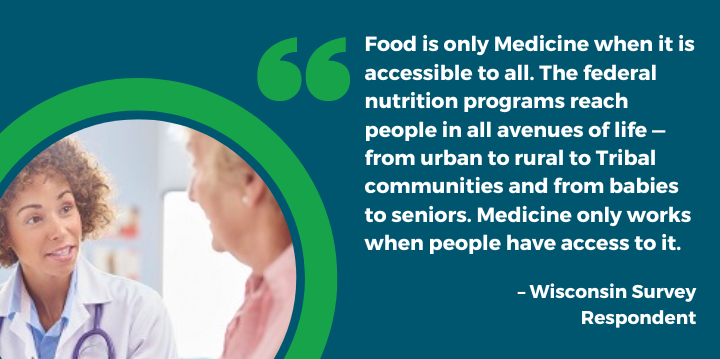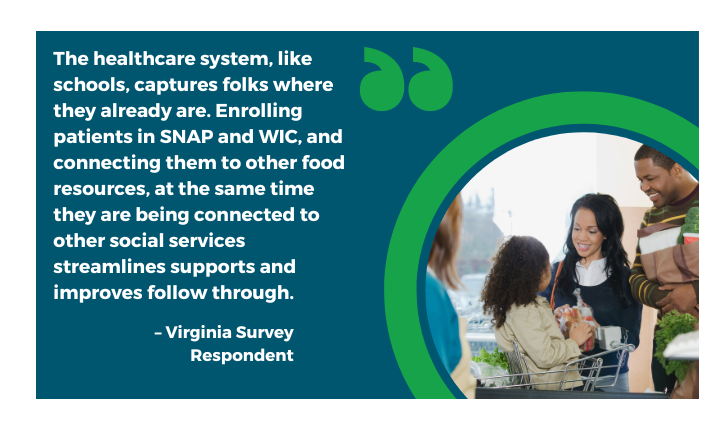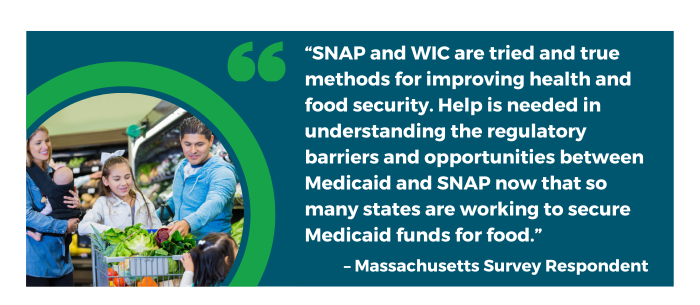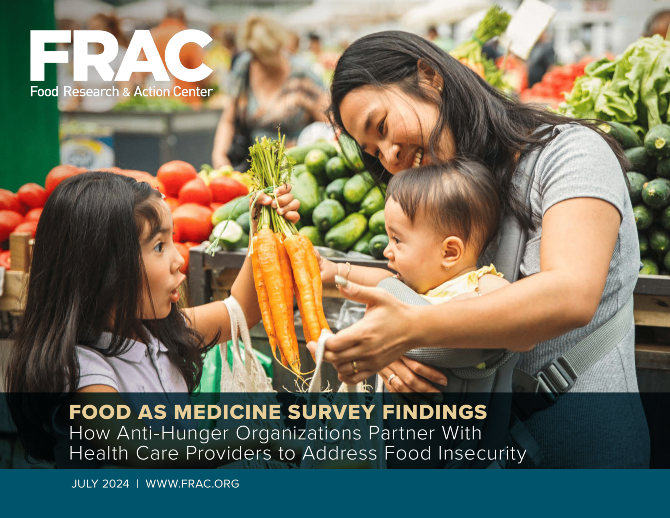A significant number of anti-hunger organizations across the U.S. that were surveyed about partnering with health care providers to connect patients to federal nutrition programs emphasized the need for additional investments to reach more patients with health–promoting programs, according to FRAC’s latest report, Food as Medicine Survey Findings: How Anti-Hunger Organizations Partner With Health Care Providers to Address Food Insecurity.
Survey on Anti-Hunger Organizations’ Approach to Food as Medicine Work
There is growing work among anti-hunger organizations to partner with health care providers to ensure that patients are connected to federal nutrition programs, particularly SNAP and WIC, and other nutrition supports.
The Food Research & Action Center (FRAC) conducted a survey to assess how state and local anti-hunger organizations are partnering with health care providers, practices, organizations, and systems to address hunger with an emphasis on learning about partnerships to connect households to the Supplemental Nutrition Assistance Program (SNAP) and the Special Supplemental Nutrition Program for Women, Infants, and Children (WIC).
This survey focused on learning about current models and activities that organizations are engaged in, as well as identifying challenges faced, and supports that would help to accelerate this work. The survey was conducted in late 2023 and early 2024. There are 56 respondents included in the survey analytic sample.
Key Findings

- Many state and local anti-hunger organizations are partnering with health care providers to connect patients to food and nutrition resources.
- While there are similarities across organizational approaches, there is not a standard model for these partnerships. Organizations cited a range of activities, partners, focus populations, and other key factors.
- Organizations face an array of challenges in this work, with the most common being related to staff capacity — theirs and that of their health care provider partners — and funding.
- Additional supports are needed to assist organizations with this work, particularly for funding and capacity, training, technical assistance, and peer learning.
- There are key opportunities to enhance this work through inputs related to the supports needed, as well as through systems change.
Survey Results In-Depth
Types of Health Care Providers Engaged in Partnerships
Nearly all respondents partner with a federally qualified health care center or community health center (80 percent) and/or a private practice or health system (73 percent).

Type of Health Care Providers (multiple responses allowed) | Percent | Frequency |
Federally qualified health care center / community health center | 80% | 45 |
Private practice or health system clinic / office | 73% | 41 |
Public health department-operated clinic | 50% | 28 |
Rural health clinic | 32% | 18 |
Other | 25% | 14 |
Patients Connected to Diversity of Programs Through Partnerships
Programs (multiple responses allowed) | Percentage | Frequency |
SNAP | 82% | 46 |
Emergency food
| 68% | 38 |
WIC | 57% | 32 |
Summer meals | 43% | 24 |
School meals | 41% | 23 |
Grocery cards
| 36% | 20 |
Older adult nutrition programs (home-delivered meals and / or congregate meals) | 32% | 18 |
Produce Rx / fruit or vegetable prescriptions | 32% | 18 |
Summer EBT | 29% | 16 |
Medically Tailored Groceries | 23% | 13 |
Afterschool meals | 21% | 12 |
Other | 18% | 10 |
Medically Tailored Meals | 13% | 7 |
Respondents indicated that they work on a number of food and nutrition programs for their partnerships with health care providers, with SNAP (82 percent) being the most common, followed by emergency food (68 percent), and WIC (57 percent).

Challenges & Needed Supports
Challenges Faced in Partnerships With Health Care Providers
Respondents were asked to share the challenges they face in partnering with health care providers to connect patients to SNAP and WIC, as well as supports that would help enhance the partnership.
Every respondent indicated that they face some type of challenge. The top challenges respondents cited were:
-
- limited staff capacity at their organization (55 percent);
- limited staff capacity at health care provider practice (50 percent); and
- lack of funding (50 percent).
Respondents also cited challenges related to application backlog at the SNAP agency (32 percent) and a complicated SNAP application process (30 percent).

Supports Needed to Enhance Partnerships With Health Care Providers
Eighty percent of respondents identified funding for additional staff time for my organization to do this work as a support needed.
Respondents also lifted up a need for funding for their health care provider partners (55 percent) and health care coverage for food insecurity interventions (45 percent).
Highlighting opportunities around training and technical assistance, respondents also noted the need for support on closed loop referrals (36 percent), training for health care providers (32 percent), resources on how organizations can do this work (29 percent), and more.

Opportunities for Advancement
Even with the substantial documented benefits of federal nutrition programs, too many eligible people are missing out on participating in SNAP and WIC. Partnerships between anti-hunger organizations and health care providers are key avenues for addressing barriers and connecting more eligible people to these essential programs. Together, anti-hunger organizations and health care partners can effectively expand awareness and utilization of federal nutrition programs.
As demonstrated in the survey findings, there are an array of successful models implemented around the country where anti-hunger organizations and health care providers are partnering to ensure that patients are connected to food as medicine interventions, including SNAP and WIC.
The survey results also underscore frequent challenges organizations face in engaging in this work and opportunities for building this work to better help patients connect to vital nutrition programs that improve nutrition, health, and well-being. Key opportunities for improvement are highlighted below.

Bolstering Partnerships Between Anti-Hunger Organizations and Health Care Providers
As demonstrated in the survey, top considerations for bolstering these partnerships to address hunger include:
- training,
- technical assistance,
- collaborative learning opportunities, and
- funding and capacity to support these partnerships.

Systems Change
While partnerships focused on referrals systems across anti-hunger partners and health care providers are essential, systems improvements need to be put into place to ensure the widest and most sustainable reach. Key improvements include:
- improving system interoperability to seamlessly connect individuals to all available programs;
- streamlining application systems to ensure that when an individual or household is enrolled in Medicaid that they also are connected to SNAP and WIC when eligible;
- data sharing to identify potentially eligible households and individuals who are participating in Medicaid and may be eligible for SNAP and WIC but not yet participating; and
- cross-agency promotion of programs, such as Medicaid agencies promoting the availability and importance of federal nutrition programs to health.
Investments in systems change will result in benefits for patients and help drive reductions in health care costs as more eligible people are connected to nutrition programs.

Food as Medicine Survey Findings: How Anti-Hunger Organizations Partner With Health Care Providers to Address Food Insecurity
Read the report
Screen & Intervene
Learn More
